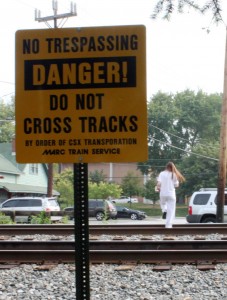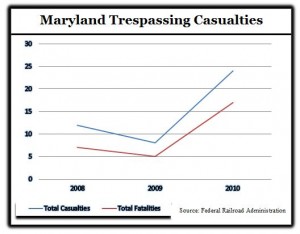
A woman trespasses recently on train tracks near the MARC station in Kensington. According to recent data, the number of casualties resulting from crossing train tracks has increased.
WASHINGTON — Three times as many people died or were injured last year trespassing on Maryland train tracks than in 2009, adding to the state’s rising number of trespasser casualties, according to Federal Railroad Administration data.
Between January and April of this year, seven people were struck and killed trespassing on train tracks in Maryland. More people died in Baltimore and Montgomery counties than anywhere else in the state. And the recent death of Ricardo Antonio Lavia, who was killed by a MARC train last week in Gaithersburg en route to Frederick, marks yet another.
Montgomery County Police Officer Janelle Smith said the 51-year-old man was not crossing the tracks with the intention of boarding a train, which is considered trespassing.
Earlier this year, an 81-year-old man died when he accidentally stepped in front of an incoming MARC train at the Gaithersburg station. In this case, the man did not heed the audible warning that signaled the approach of an oncoming train — an event also classified as trespassing.
Though casualty — both injury and death — figures after April of this year have not been released, previous FRA data show a jump in fatalities last year. In 2009, five people died trespassing — one year later, the number increased to 17.
More than half of the casualties in that period took place in Baltimore and Montgomery countries — six in each county.
Marmie Edwards of the railroad safety nonprofit Operation Lifesaver, said Maryland, ninth in the country in number of trespassing deaths, isn’t alone.
“I will say that 2010 was a year that there was an increase in trespassing across the country,” Edwards said. “I really have not been able to pin down exactly why.”
The “Why?” question torments railroad safety advocates like Edwards, who are trying to get to the root of the problem.
“There have been all these improvements in almost virtually every other area of rail safety, and this continues to be a recurring problem,” FRA spokesman Warren Flatau said of trespassing.
Any number of variables could cause a trespassing accident, so his agency tries to identify patterns. Distraction is often a factor, he said, as people on cellphones or listening to music with headphones might not hear an oncoming train. Another is a change in city traffic or development patterns that could reroute commuters, making a shortcut across the tracks seem more convenient.
Purported improvements to prevent trespassing, such as erecting fencing and signs near the tracks, have met with mixed results, Flatau added.
 Warning signs along MARC train lines are installed by track owners CSX and Amtrak, not by the Maryland Transportation Administration, which owns the MARC system, said MTA spokesman John Wesley.
Warning signs along MARC train lines are installed by track owners CSX and Amtrak, not by the Maryland Transportation Administration, which owns the MARC system, said MTA spokesman John Wesley.
“Although some of these signs are located close to MARC train stations, warning pedestrians about the dangers inherent in trespassing on the tracks” is the responsibility of those contractors, Wesley said.
Meanwhile, MTA provides information about track safety to the 18,000 customers who have signed up for email alerts, Wesley said. After Friday’s accident, the agency sent a message to subscribers but plans no further action.
Operation Lifesaver has attempted to reach various age groups through its Facebook, Twitter and YouTube pages, as well as through public service announcements that aim to put a face to the numbers.
More frequently, some of those videos are designed for an older crowd, Edwards said, as more people in their 40s and 50s are trespassing nationwide, a trend reflected in Maryland figures. Only one person younger than 35 years old was struck and killed while trespassing in the state this year.
Despite the nonprofit’s efforts, some people still aren’t getting the message.
“Sometimes we really feel like we’re just preaching to the choir,” Edwards said.
When “there’s not metal wrapped around these people” the coverage is minimal, and it’s not always top of mind.
Flatau offered the refrain he often returns to when talking about railroad safety.
“Would anyone seriously consider just short-cutting across the Beltway?” he said “It’s the same type of logic. It’s just that with rails, people, for whatever reason, just don’t associate hazards they might otherwise.”
